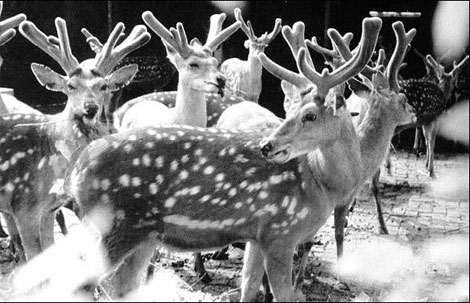Deer are a way of life in this town in the Northeast
|
Dongfeng county, in Jilin province, is known as the home of sika deer breeding. Provided to China Daily |
The sika deer, which is valued for its medicinal properties, has become a sort of industry for one town in Jilin province, in Northeast China, thanks to artificial breeding.
Dongfeng has in fact become known as the sika deer town. It opened its first State-owned deer farm and deer-breeding center back in 1947 and has flourished over the past 60 years, setting up eight other similar deer farms.
For many years now, the county and surrounding areas have been the nation's top producer of pilose antlers, a common ingredient in traditional Chinese tonics that help the blood, bones, and joints.
The Dongfeng deer is one of six major sika species in China, and the result of 31 years of breeding efforts, and five generations of deer.
Its breed was recognized by the Ministry of Agriculture in 2004 as a new kind, with genetic stability and strongly disease-resistant.
The "Dongfeng sika" breed has also been registered as a geographical indicator by the State Administration for Industry and Commerce.
Its pilose antlers, as well as the blood and the tail can be found not only on the domestic market, but also in many Southeast Asian nations.
The county has provided more than 10,000 high-quality deer to cities across the nation and had around 165,000 deer by the end of last year. Altogether, there are 6,800 deer farms and individual deer raisers.
The Sanhelinlu Company has more than 4,000 deer at its farm, and is the nation's largest source of deer for breeding.
The Dongfeng Pharmaceutical Co Ltd, another prominent local company involved in the business, cooperates with a number of research organizations, such as the Chinese Academy of Agricultural Sciences' Institute of Special Economic Animal and Plant Science and the Changchun University of Chinese Medicine. They have worked together on 32 types of medicines based on deer products, and 30 other types of healthy food.
The maji pilose antler, known for its processing techniques, is recognized as a national standard of pilose antler quality.
The local government has preferential policies to encourage investment in the deer business, and seven of is townships have been nominated as deer-breeding bases. Each of them is expected to have more than 20,000 deer on average by the end of this year.
They have also spent more than 300,000 yuan ($47,000) on an official website, to shine a light on the sika deer town.
Sika deer breeding is a part of China's traditional Chinese medicine modernization plan and the government has made a longer-term development plan for the next decade.
It plans to spend more than 3 billion yuan on 14 projects, including deer breeding, deer product processing, and even deer culture and tourism.
(China Daily 08/26/2011 page14)















